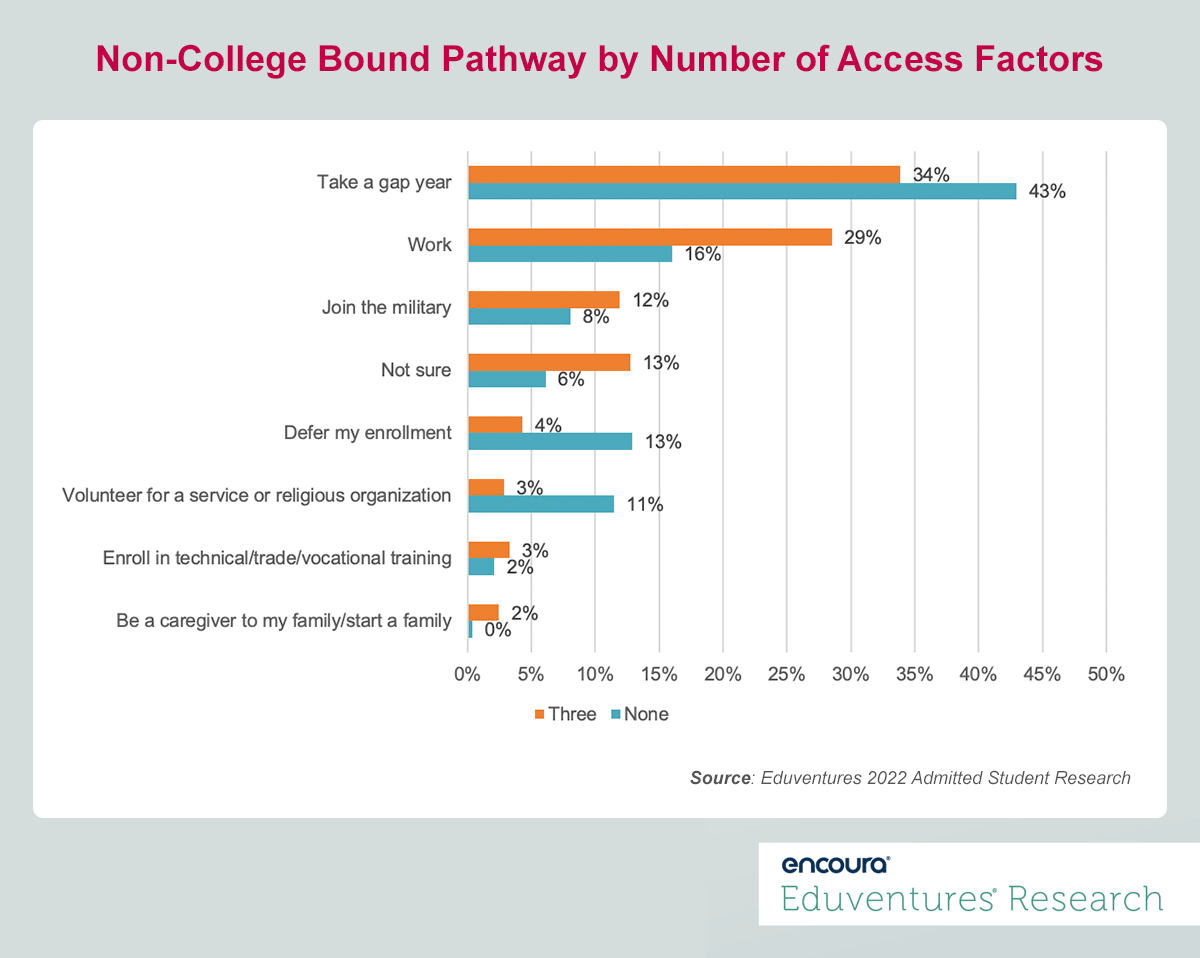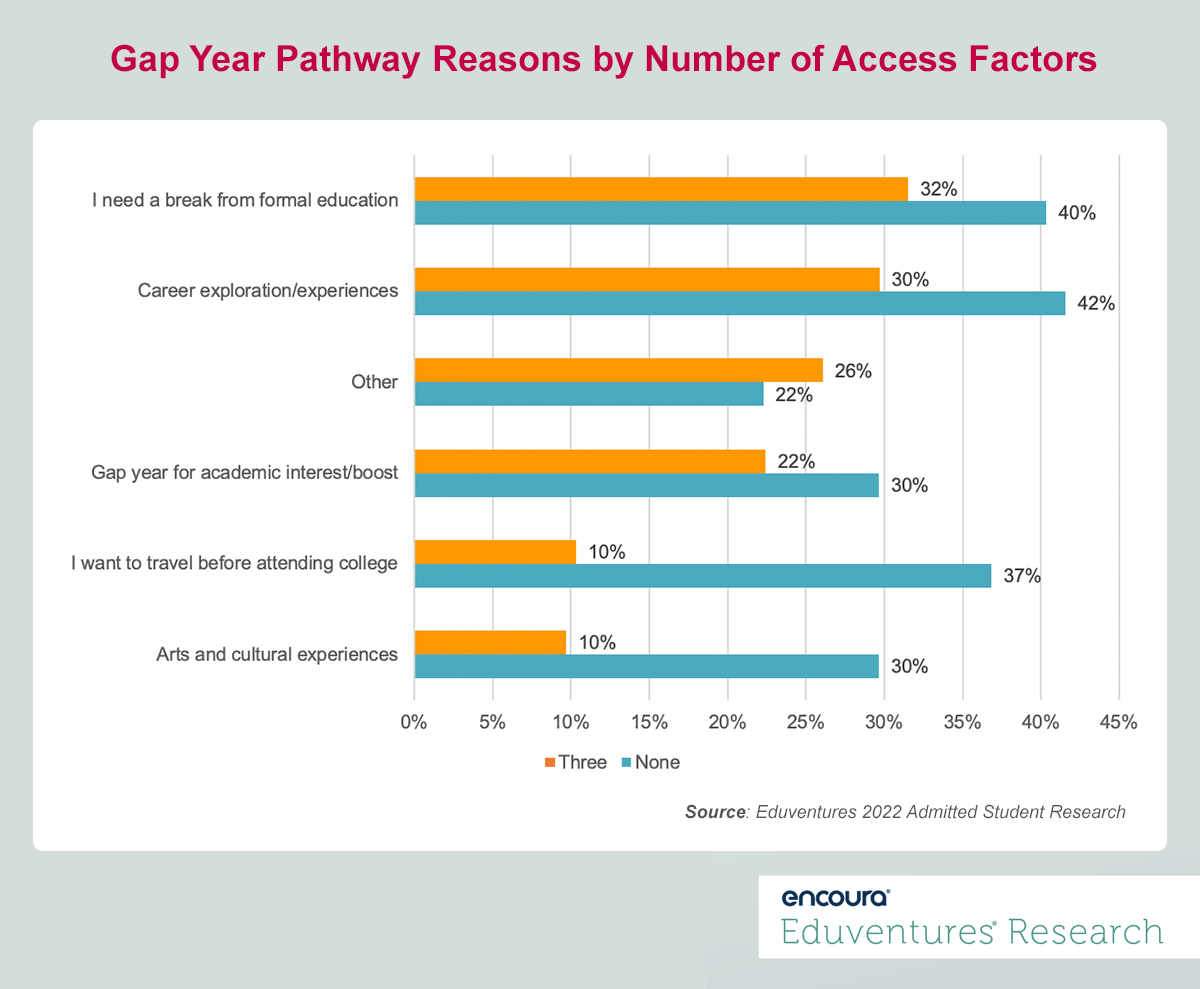June 14-16, 2023
Intercontinental Boston–Boston, MA
Pandemic-induced enrollment declines have reshaped the composition of freshman classes. Eduventures’ 2022 Admitted Student Research™ sample shows a decline of 11% among first generation students and 13% among those from low-income households, compared to a 67% increase in students from high-income families between 2019 to 2022.
The students who dropped out of the process were also most likely to be career-minded while those who remained were more focused on academics. The Experiential Interests™ and Career Pragmatists™ Prospective Student Mindsets™—the two most career-focused—declined among key demographics by as much as 10% or more.
Our Admitted Student Research collects data on students who have been accepted to higher education but have decided against enrolling. About 5% of students from our sample fell into this “Alternative Pathway” category, joining the 33% of students nationally who decided not to immediately enroll in either a two-year or four-year institution directly out of high school. Instead of college, these students had plans to go straight into the workforce, take a gap year, or enter the military, among other options.
Depending on the pathway, the demographics of the students and reasons for their choices shifted significantly. Figure 1 shows how students who are first-generation, under-represented minority, and from low-income households—Eduventures’ definition of “access factors”—choose their pathways differently than those with no access factors.
Figure 1
In Figure 1, an image of those who have and those who have not emerges. Alternative Pathway students with three access factors are more likely to choose work or say they are “not sure” about their next steps. Those with no access factors are more likely to choose a pathway that allows them to simply delay enrollment, such as taking a gap year.
But the gap year was also the top choice for those with many access factors. Why is that?
The answer may lie in how these two groups define a “gap year.” Figure 2 compares the reasons why students decided to take a gap year, again comparing the responses of those with no access factors to those with three access factors.
Figure 2
Here a picture emerges of two different definitions of what a gap year is: one that is structured and one that is unstructured.
The Structured Gap Year
Those with no access factors are more likely to follow the traditional gap year definition, i.e., to take time between high school and college for experiential learning, often through structured programming. In our sample, more than a third of students without access factors (37%) indicated they planned to travel for a year (vs. just 10% with three access factors). Almost a third cited arts and cultural experiences (30% vs. 10%) and the pursuit of academic interests (30% vs. 22%). While the gap between these two groups on these answer choices is wide, these answer choices were not the most popular among this group.
The top two answer choices for students with no access factors were career exploration (42%) and needing a break from formal education (40%), which were also the most popular among students with three access factors (30% and 32%, respectively). This indicates that the job market presented the most compelling opportunity and that students from both groups weren’t quite sure what they wanted to do with their lives just yet. It may also indicate that the return on investment (ROI) of college wasn’t entirely clear.
The Unstructured Gap Year
Those with three access factors did not choose as many reasons as their peers, selecting an average of 1.5 choices compared to 2.5 choices—perhaps an indication of fewer options available to them. Beyond selecting “I need a break from formal education” and “career exploration/experiences,” they were also slightly more likely to cite “other” (26% vs. 22%).
Their open-ended responses to the option “other,” were revealing and largely centered on uncertainty around COVID-19. Many were mostly waiting to see the outcome of COVID-19 in their own lives before deciding to make the investment in a college education. Indeed, 28% of this group indicated that they could not afford college at this time vs. 9% with no access factors.
The Bottom Line
Knowing that a sizeable population of students goes through all the steps of applying and getting accepted only to not enroll means that these students aren’t lost from the cycle forever. It is more important than ever to stay engaged with these students. In doing so, keep in mind:
- Keep in touch. Too often we see these students drop out of the pipeline and lose touch with schools they were interested in. This is a missed opportunity for both school and student. The gap year is an important time to stay top-of-mind and make a stronger case for enrollment.
- Create convincing content for those in the workforce. The current high-wage/high-inflation environment has further complicated college choice for many students. The highly career-oriented students who entered the workforce will need to understand how a degree leads to a better job. Consider the most appropriate majors for these students that align to career-oriented Mindsets like health care, criminal justice, and education. Tell a compelling career story.
- Make your ROI clear. It has been said a lot but bears repeating: career-oriented students must be able to clearly see the ROI of a college degree. Showcase the ROI of your career-oriented programs. Highlight success stories from alumni with similar life experiences. Step up communication around financial aid options and the process to help students feel more confident in pursuing higher education.
- Capitalize on experiences. Remember that those putting off enrollment are getting an experience they can’t get in college. These experiences are valid and matter. Explain how their gap year experiences will enrich their college experiences. Feature students who took a gap year and are thriving.
If we want to recapture students who have decided to take a break, we have to acknowledge their pathways and speak to them.
Never Miss Your Wake-Up Call
Learn more about our team of expert research analysts here.
Eduventures Senior Quantitative Research Analyst
Contact
This recruitment cycle challenged the creativity of enrollment teams as they were forced to recreate the entire enrollment experience online. The challenge for this spring will be getting proximate to admitted students by replicating new-found practices to increase yield through the summer’s extended enrollment cycle.
By participating in the Eduventures Admitted Student Research, your office will gain actionable insights on:
- Nationwide benchmarks for yield outcomes
- Changes in the decision-making behaviors of incoming freshmen that impact recruiting
- Gaps between how your institution was perceived and your actual institution identity
- Regional and national competitive shifts in the wake of the post-COVID-19 environment
- Competitiveness of your updated financial aid model



